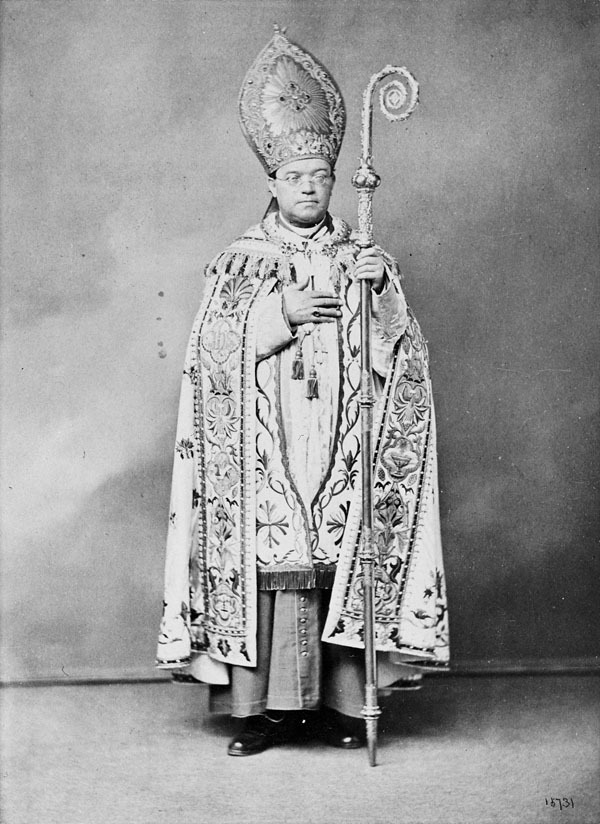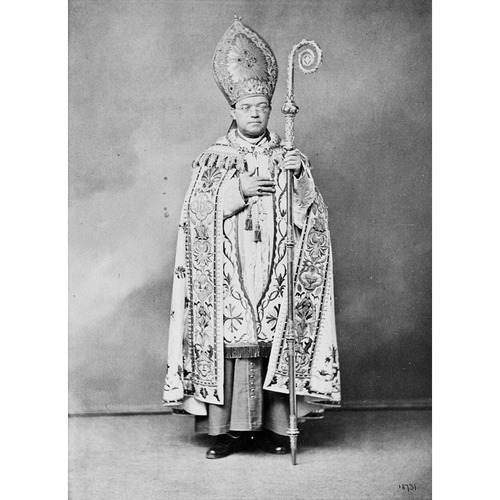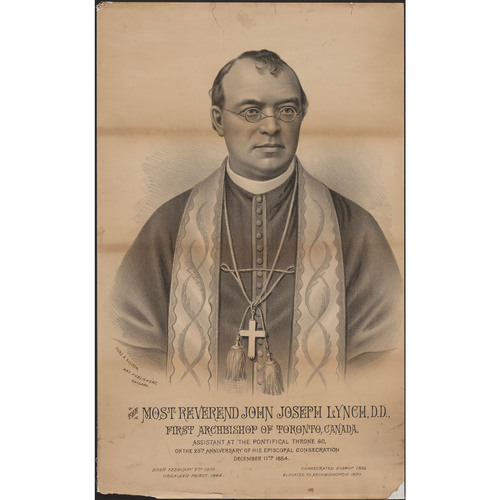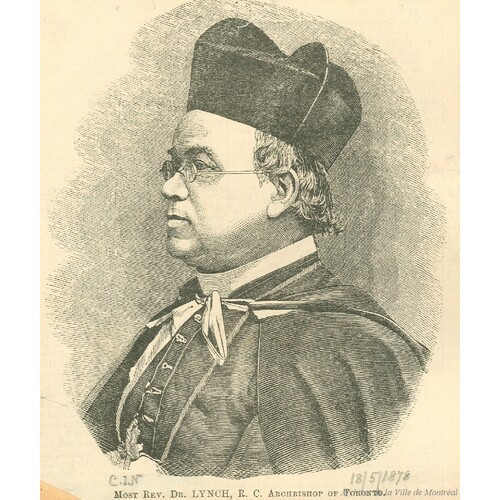LYNCH, JOHN JOSEPH, Lazarist, Roman Catholic priest, and archbishop; b. 6 Feb. 1816, probably in County Fermanagh (district of Fermanagh, Northern Ireland), son of James Lynch and Ann Connolly; d. 12 May 1888 in Toronto, Ont.
Although commonly thought to have been born in Clones (Republic of Ireland), John Joseph Lynch was probably born in nearby County Fermanagh. He received his early education in Lucan, County Dublin, before attending the Academy of St Joseph in Clondalkin and, in 1835, the Lazarist St Vincent’s College at Castleknock. In 1837 he entered the seminary of Saint-Lazare in Paris and four years later took the vows of the Congregation of the Mission (whose members are also called Lazarists or Vincentians). Having committed himself to a missionary society, Lynch expected an overseas posting; consequently he was dismayed at being sent to labour for the church in his native land. He returned to Ireland where he was raised to the priesthood at Maynooth, County Kildare, in June 1843. His earlier disappointment evaporated when, in 1846, after three years of work at St Vincent’s College and as a missionary in various parts of Ireland, he was sent to Texas.
Lynch served as a saddle-bag preacher in that state at the time of the Mexican-American War. Unfortunately, the life of an itinerant preacher left him vulnerable to typhoid fever. Experiencing an attack from which he could not completely recover in the deep south, he was moved to one of the Lazarist institutions, St Mary’s of the Barrens, Perryville, Mo. After a brief recuperative stay, he was named superior of this seminary in 1848, a position he held until 1856. He then took up the assignment, which he had sought, of establishing a seminary for his congregation at Niagara Falls, N.Y. When the necessary land and funds had been acquired he founded Our Lady of Angels (later Niagara University).
During the mid 1850s the second bishop of Toronto, Armand-François-Marie de Charbonnel*, a vigorous battler for Catholic expansion, had been seeking relief from his episcopal duties. Lynch was suggested as a possible successor and he was invited to Toronto in 1858 for a summer mission and, obviously, for careful scrutiny. What made Lynch attractive to Charbonnel, in addition to his administrative and preaching abilities, was his Irish background, a matter of no small consequence considering the ethnic composition of Toronto’s Catholic population at that time. Lynch was consecrated as coadjutor bishop on 20 Nov. 1859, with rights of succession. The following year Charbonnel finally obtained release from his post in order to pursue a monastic life in France; Lynch became the third bishop of Toronto on 26 April 1860.
The situation Lynch inherited was an encouraging one. In Toronto’s population of 45,000, the Catholics, largely of Irish birth, numbered 12,000, their strength exceeded only slightly by members of the Church of England. More positive still, Catholic numbers were increasing at a greater rate than the population as a whole. Thanks in part to his predecessor’s efforts, Roman Catholic separate schools, financed by government grants and taxes from supporters, were well established legally, notably by the act passed by the government of Sir Allan Napier MacNab* and Étienne-Paschal Taché* in 1855, known as the Taché Act. Furthermore Charbonnel had supervised the establishment of St Michael’s College under the Basilian direction of Jean-Mathieu Soulerin* and had brought in members of the Christian Brothers and the Sisters of St Joseph to serve as instructors in the separate schools.
Yet there were problems. The seemingly aggressive growth of Catholicism and its institutions in the 1850s had evoked a Protestant response; harsh words, bitter politics, and spilled blood were also features of that decade. The increase in Catholicism had also outstripped the resources of the church in Canada West, with the result that in 1859 in the diocese of Toronto, which included the counties of Ontario, Peel, Simcoe, York, Lincoln, and Wetland, there were only 43 churches and approximately 36 priests. So while prospects might be bright, Bishop Lynch, who was no fool, knew that the future would not present clear sailing.
The growing strength of Irish Catholicism, and of the Protestant reaction, forced Lynch into the public limelight in subsequent years, just as surely as it was a factor in his appointment as a prelate assistant to the papal throne in 1862 and in his elevation to first archbishop of Toronto on 15 March 1870 while he was attending the Vatican Council in Rome. (As a result of Lynch’s appointment, the diocese of Toronto became a metropolitan see with the bishops of the dioceses of Kingston, Hamilton, and London as suffragans.) Thus Lynch was consulted by Egerton Ryerson on the separate school legislation proposed by Richard William Scott* in 1863, which in its final form remedied some of the deficiencies of the Taché Act. Lynch supported the new legislation and with its passage declared himself “quite satisfied,” but when confederation approached he hoped for fresh arrangements for separate schools in Ontario. The Scott Act, however, formed the basis of the province’s separate school system. Lynch’s consultations with Ryerson also led to his appointment to the Council of Public Instruction, on Ryerson’s recommendation.
After 1867 Lynch simply sought improved conditions for separate schools, but he did not pursue this goal as aggressively as had Charbonnel. He would have preferred the establishment of separate high schools and separate normal schools in Ontario, but he was conscious of the fact that Catholic ratepayers, many of them of the working class, would not be able to bear an additional burden. In any event, to his conservative eyes, a high school education might raise student expectations beyond a warranted level. Consequently the bishop was satisfied with minor amendments to the school law in 1877, 1879, and 1886 which facilitated the assessment of Catholic ratepayers as separate school supporters and increased the borrowing powers of separate school trustees. For his apparent contentment and his warm relationship with Oliver Mowat*, Liberal premier of Ontario after 1872, Lynch was subjected to criticism by fellow Catholics including bishops James Vincent Cleary* of the diocese of Kingston and John Walsh* of the diocese of London who wanted a tougher stand for concessions to separate schools. His lack of aggressiveness came from his understanding that in a strongly Protestant province no government dared show excessive generosity to Catholics. In addition, he probably questioned the wisdom of a return to the heated and often unproductive exchanges of the 1850s. Lastly, he recognized that separate schools, whatever their constitutional safeguards, existed on Protestant sufferance and after 1867 without the support of the Catholic majority in Quebec which they had received under the Union. The percentage of Toronto’s population that was Catholic was slowly decreasing during the 1870s and 1880s; Catholics had declined to 19 per cent of the total population by 1881 and were outnumbered not only by members of the Church of England but also by the Methodists. The archbishop was careful; his chief concern would be cautiously nurturing growth, not vigorously seeking conquest.
Despite his caution, Lynch was dragged into battles with both Catholics and Protestants. In March 1876 members of the “lay party” of the Toronto Separate School Board, including its chairman, Remigius Elmsley, began to call for an accounting by the archbishop of the episcopal corporation’s management of school properties and were supported in their efforts by Patrick Boyle*’s Irish Canadian. This assault was followed by demands in 1879, 1882, and 1887–88 for the use of the ballot to replace open voting in separate school board elections. In his dual capacity as archbishop and separate school superintendent, Lynch fought back against the rebels. His tough, conservative stance was not simply inspired by a desire to remain the unchallenged chieftain of Toronto Catholics; he was deeply worried lest divided Catholicism lend itself to a successful Protestant assault which could place the separate schools in jeopardy. Accordingly, he viewed the malcontents as more than mischievous; they were wicked. He used every weapon in his considerable arsenal – his position, sermons, letters, and the refusal of absolution – to defeat the rebellious element in the lay party on both issues.
These quarrels invited Protestants to enter the fray, particularly in the cause of the secret ballot. The interference of militant Protestants, such as Robert Bell, Conservative member of the Legislative Assembly for Toronto West from 1875 to 1879, was motivated, in part, by the desire to shape an issue which would defeat Oliver Mowat who, they charged, was closely allied with, if not dictated to by, Archbishop Lynch. Thus, in 1882, when the Catholic leader suggested the withdrawal of Sir Walter Scott’s poem, Marmion, from study for matriculation on the grounds that it was offensive to Catholics, and the minister of education, Adam Crooks, temporarily complied, provincial Conservatives and the Mail were quick to scream papist domination. In 1884–85 Lynch was made privy to education minister George William Ross*’s selections from the Bible which were to be used in public schools, and his editorial and administrative suggestions were accepted. The Conservatives under William Ralph Meredith* raised this issue, particularly during the course of the provincial election campaign of 1886. The bishop once more found himself in the centre of a storm, largely because of his concern for Catholic children who were being educated in public schools. The archbishop would have preferred to avoid being dragged into political debate and would rather have worked quietly with Mowat, a man whom he admired and no doubt favoured, especially in the light of the behaviour of provincial Conservatives during the later years of his episcopacy. The archbishop’s preference for Mowat must have had an impact upon the province’s Catholic voters.
Lynch kept a watchful eye on other political developments: urging patronage appointments for Irish Catholics at provincial and federal levels, pressing John A. Macdonald* to consider Catholics as political candidates and senators in March 1867, arguing with George Brown* on “the advisability of taking an Irish Catholic into the new Cabinet of the Liberal party” being formed by Edward Blake* in 1871, and denouncing to Blake’s successor, Mowat, the probable passage of a bill to incorporate the Orange order in 1873. Lynch’s relationship with the federal Conservatives was never as consistent as with the Ontario Liberals; Macdonald none the less actively sought his support on several occasions and received cautious but favourable replies.
His Irish background and his desire for the well-being of his church provided the inspiration for the archbishop’s political activities. His frequent lectures on Catholic doctrine and belief were widely attended by both Catholics and Protestants. Soon after his return from Rome in 1870 he spoke about the Vatican Council and his support for the doctrine of papal infallibility during the council’s proceedings. An able if somewhat autocratic administrator, he oversaw the rapid expansion of his diocese. During his incumbency 70 priests were ordained; two priests of the diocese, Jean-François Jamot and John Walsh, were elevated to the episcopacy; and, in addition, 40 churches, 30 presbyteries, and 7 convents were established. Lynch convoked diocesan synods in 1863 and 1882, as well as a provincial council in 1875 which passed decrees regarding devotions, administration, and finances. Furthermore, he struck out in new directions in the development of benevolent institutions: enlarging the House of Providence, creating the St Nicholas Home for Working Boys, founding the Sunnyside Orphanage for boys, and establishing the Notre Dame Institute, a boarding-home for working girls and female students attending Toronto Normal School. All of these institutions were under the supervision of the Congregation of the Sisters of St Joseph. In encouraging these developments, the archbishop was not only protecting Catholic souls but was sensitively responding to the developing social problems attendant upon Toronto’s urban growth.
Archbishop Lynch was deeply concerned about Ireland, advocating Home Rule for his native land on the grounds that in North America the Irish had shown themselves to be remarkably responsible citizens. But the Irish people were more than that to him: they were a chosen people destined to preserve and extend the true faith throughout the world. Given this providential destiny, he was most anxious that the Irish should appear well in the eyes of all, and yet he knew only too well the less than flattering stereotype that existed in Ontario. An Irishman who did half the wrong of others received twice the blame. So, although not an abstainer himself, he urged the Irish to practise temperance, believing that under the influence of alcohol “the Irishman becomes more unreasonable than men of other and more plodding temperaments.” He also pleaded for workers to reclaim the victims of alcohol. Lynch’s experiences in Texas and in Canada had convinced him that Irish immigrants should be discouraged from movement to locations lacking sufficient Roman Catholic clergy. Mass migration, he argued, frequently stripped his people of their religion. He demonstrated these concerns throughout his career, addressing open letters to the clergy of Ireland in 1865 and 1883, and fighting vigorously for the protection of separate schools in Ontario.
Never a robust man, Lynch became ill in 1882 and acquired the assistance of Timothy O’Mahony as auxiliary bishop. Yet he remained to the end a warrior for his church and his people. In 1884, when he celebrated his jubilee as bishop of Toronto, prominent civil and ecclesiastic figures paid tribute to the achievements of the past 25 years. A mark of his devotion is that when he died he left an estate of less than $500.
John Joseph Lynch was the author of several published pastoral letters as well as Questions and objections concerning Catholic doctrine and practice: answered by John Joseph Lynch, archbishop of Toronto (Toronto, 1877).
Arch. of the Archdiocese of Toronto, Lynch papers. PAC, MG 26, A, 228. [J. J. Lynch], “Archbishop Lynch and the Knights of Labor,” ed. G. J. Stortz, Committee on Canadian Labour Hist., Bull. (Halifax), 6 (autumn 1978): 2–3. Globe, April–May 1888. Cyclopædia of Canadian biog. (Rose, 1886), 691–92. Dent, Canadian portrait gallery, I; 141–45. Standard dict. of Canadian biog. (Roberts and Tunnell), II: 245–48. Daniel Conner, “The Irish-Canadian: image and self-image, 1847–1870”
Cite This Article
Charles W. Humphries, “LYNCH, JOHN JOSEPH,” in Dictionary of Canadian Biography, vol. 11, University of Toronto/Université Laval, 2003–, accessed January 11, 2026, https://www.biographi.ca/en/bio/lynch_john_joseph_11E.html.
The citation above shows the format for footnotes and endnotes according to the Chicago manual of style (16th edition). Information to be used in other citation formats:
| Permalink: | https://www.biographi.ca/en/bio/lynch_john_joseph_11E.html |
| Author of Article: | Charles W. Humphries |
| Title of Article: | LYNCH, JOHN JOSEPH |
| Publication Name: | Dictionary of Canadian Biography, vol. 11 |
| Publisher: | University of Toronto/Université Laval |
| Year of publication: | 1982 |
| Year of revision: | 1982 |
| Access Date: | January 11, 2026 |






